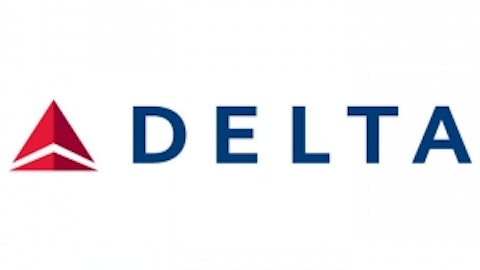It is not common for airline companies to instate dividends. Instead, carriers implement share-buyback programs to bring capital appreciation to their shareholders. Delta Air Lines, Inc. (NYSE:DAL) has instated a modest 1.3% dividend offer and a $500 million share-repurchase program. Based on the analysis of its latest quarterly earnings report and monthly traffic reports, I believe its dividend offer may be a good idea.
Brief fundamental metrics
Delta Air Lines, Inc. (NYSE:DAL), a $15.2 billion by market capitalization carrier, is trading with a P/E of 17, and a forward P/E of just under 6. Its PEG ratio is 0.7. The stock has rallied 50% year-to-date, and 64% on a 12-month trailing basis. The company may look attractive to the value-oriented investor at first sight.
Analysis of 1Q 2013 performance
(For space saving, the following metrics will be compared from 1Q 2012 to 1Q 2013, so reiteration is avoided.)
According to the company’s most recent earnings report, Delta Air Lines, Inc. (NYSE:DAL)’s net profit totaled $85 million, an improvement of $124 million on a year-over-year basis. What’s more is that Delta generated $1.1 billion of operating cash flow, and $457 million in free cash flow. Its adjusted net debt totaled $11 billion by the end of the quarter.
Furthermore, Delta Air Lines, Inc. (NYSE:DAL) was operating 719 aircraft by the end of the quarter, 51 less from a year ago. Personally, I like Delta’s strategy regarding reducing its costs of operation by returning unnecessary aircraft to lessors and selling them to other airlines.
Let’s compare Delta Air Lines, Inc. (NYSE:DAL)’ metrics against other major airlines to provide color regarding its quarterly performance.
US Airways Group, Inc. (NYSE:LCC)’s
1Q 2013 total revenue increased 3.5% from about $3.3 billion to approximately $3.4 billion. Its operating costs increased 2.2%, below the 3% rise of Delta’s, from $3.2 billion to approximately $3.3 billion. Its aircraft-fuel costs increased by 0.2%, and its salaries and related expenses rose 5%. After non-operating income expenses, the company’s net income declined 8.3% from $48 million to $44 million.
United Continental Holdings Inc (NYSE:UAL) increased its revenue by 1.4% from $8.6 billion to $8.7 billion. Its operating expenses increased 1.3% from $8.8 billion to approximately $8.9 billion. By delving its operation costs, aircraft-fuel expenses decreased 5.5%, but salaries and related expenses rose 12%. Overall, due to less costs of operation, the company’s net loss narrowed from from a loss of $448 million to a loss of $417 million.

United Continental Holdings Inc (NYSE:UAL) is reducing its operation costs by replacing its B767-200 and B757-200 aircraft with the more fuel-efficient version, the B737-700. This should help increase its net income. However, its future still looks shady. The carrier is under huge pressure from regional airlines. JetBlue Airways Corporation (NASDAQ:JBLU) has inaugurated new routes from the International Airport of Houston, one of United Continental’s main hubs.
On the contrary, US Airways Group, Inc. (NYSE:LCC) is expanding its fleet, a sign of growth. Its fleet is mainly composed by Airbus aircraft. The last portion of its The Boeing Company (NYSE:BA) B737s will be decommissioned by 2014, and it will be replaced by Airbus A321 models. The company is showing signs of growth, and it should be under every investor’s radar.
Delta’s April monthly traffic report
According to Delta Air Lines, Inc. (NYSE:DAL)’s most recent monthly traffic report, the company’s revenue passenger miles (RPM) declined 0.7% from 15.6 billion in April 2012 to 15.5 billion in April 2013. Considerable weakness in the regional market led to a 7% decline in regional RPM. However, the decline in revenue was offset by its international sector.

